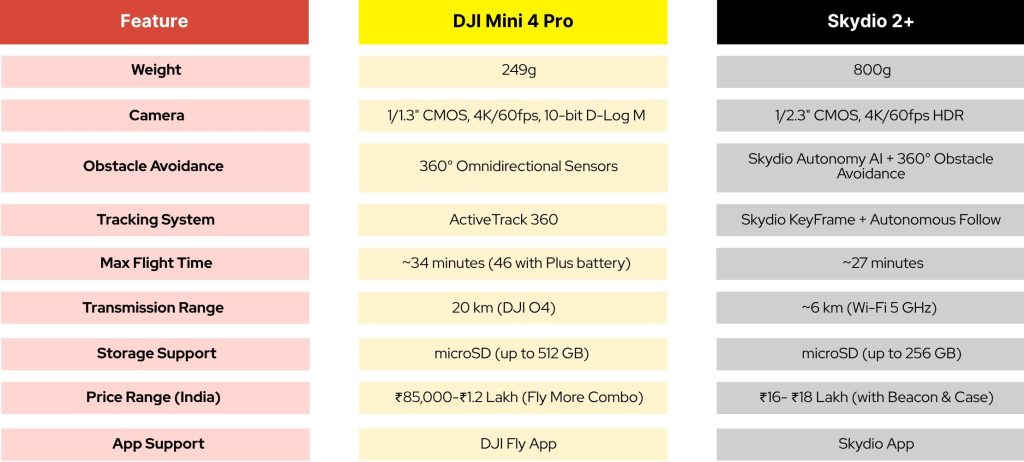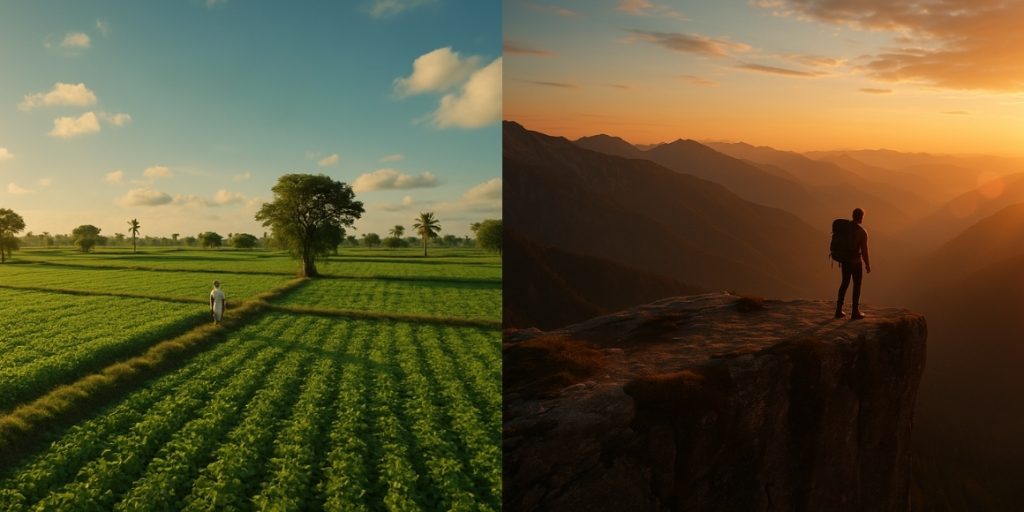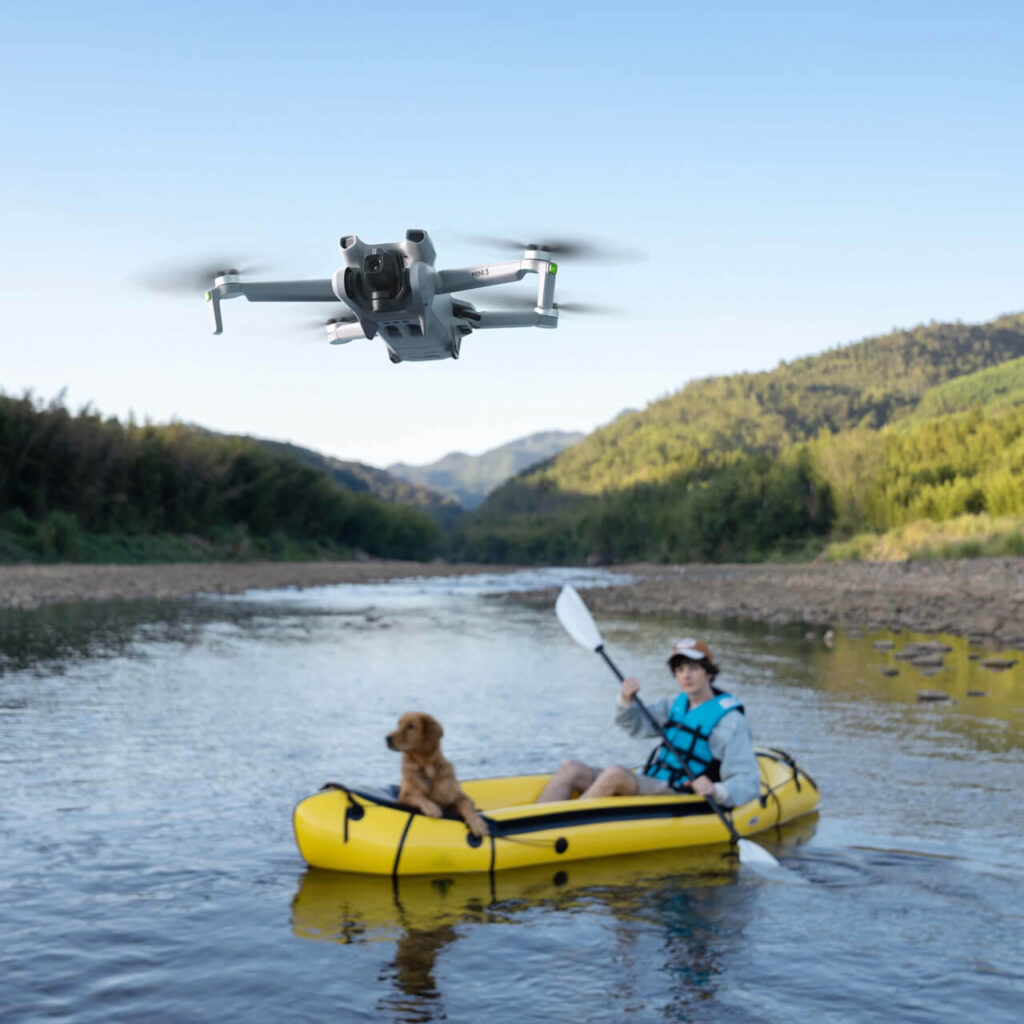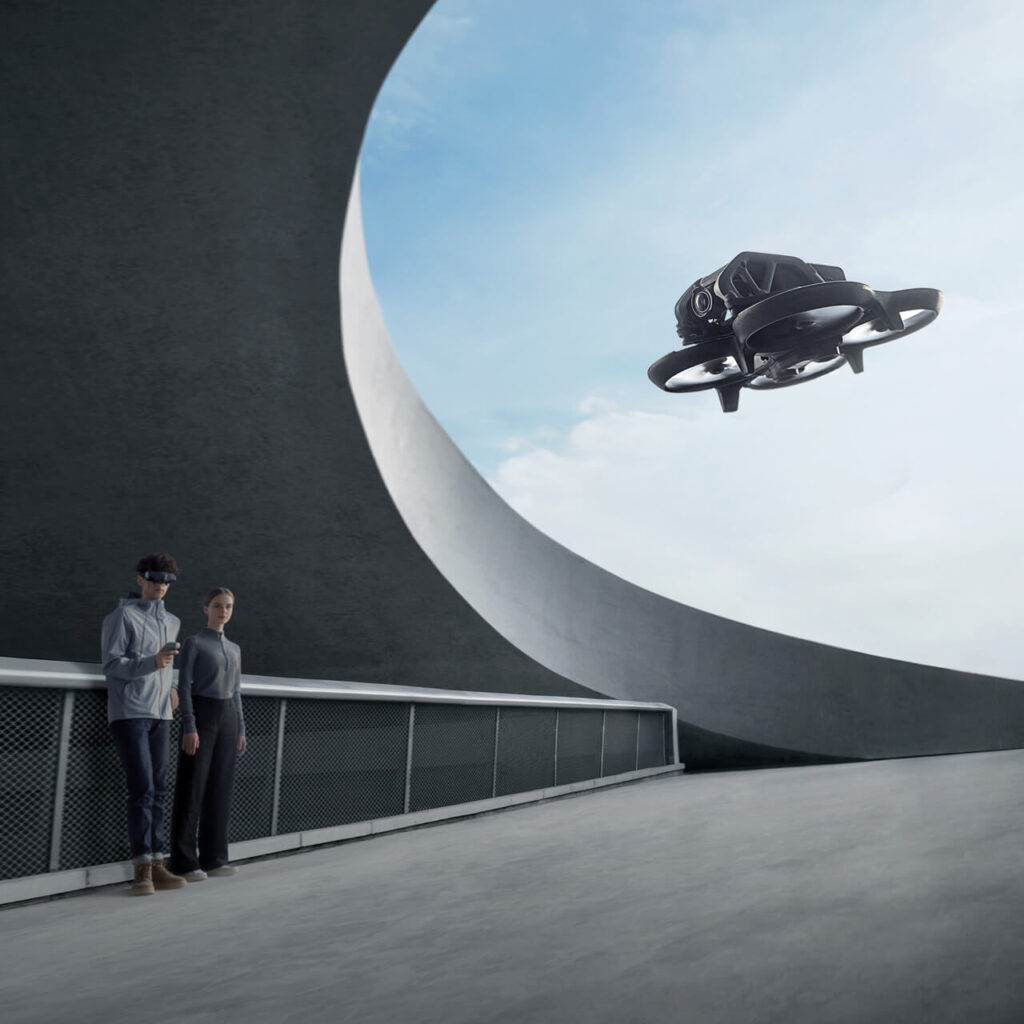When choosing a drone that excels at tracking moving subjects whether you’re filming action sports, documenting wildlife, or capturing dynamic travel scenes two models often stand out: the DJI Mini 4 Pro and the Skydio 2+. Each brings its own strengths:
- The DJI Mini 4 Pro is designed for portability, advanced cinematic features, and extended flight time.
- The Skydio 2+, on the other hand, is renowned for its industry-leading obstacle avoidance and autonomous tracking capabilities.
In this comparison, we’ll break down:
- Core specifications (camera, battery, weight, range)
- Tracking and obstacle avoidance performance
- Ease of use
- Portability and suitability for different users
- Price, warranty, and purchasing insights from Jetayu Gadgets
Whether you’re a solo content creator, outdoor enthusiast, or enterprise user seeking precision tracking, this guide will help you determine which drone best matches your needs.
Key Specs at a Glance
Before we dive into the tracking power of these two drones, let’s start with a quick side-by-side comparison.

Quick Take:
- The Mini 4 Pro wins on size, transmission range, and low-light camera performance.
- The Skydio 2+ leads when it comes to advanced autonomous tracking and real-time obstacle navigation.
If you’re still unsure whether to go for the Mini 4 Pro or its predecessor, this detailed breakdown on the DJI Mini 3 vs Mini 4 Pro can help clear things up.
Tracking Performance: Precision, Intelligence & Real-World Use
When it comes to autonomous tracking, both the DJI Mini 4 Pro and Skydio 2+ offer impressive capabilities but they do it in very different ways.
DJI Mini 4 Pro: ActiveTrack 360
DJI’s ActiveTrack 360 is a major upgrade over the older versions. It allows you to:
- Choose flight paths dynamically around, beside, or in front of your subject.
- Set tracking angles and distances with smooth cinematic transitions.
- Use omnidirectional obstacle sensing to fly safely even in complex environments.
Limitations:
- It still relies on user input to set paths.
- In extremely tight or fast-moving scenarios, the drone might struggle to stay locked onto the subject.
Still, for content creators, travelers, and everyday users, it’s a smooth, beginner-friendly tracking experience. No surprise that first-time buyers often fall in love with flying through the DJI Mini 4 Pro, making it a top pick for casual and semi-pro users alike.
Skydio 2+: Autonomous Intelligence Redefined
Skydio has built its reputation around tracking. The 2+ doesn’t just follow you it thinks.
- Powered by Skydio Autonomy Engine, it uses six 4K navigation cameras to see in all directions.
- It maps out the environment in real-time and predicts your path even if you’re biking through trees or running under a bridge.
- Skydio’s KeyFrame feature lets you set custom paths for repeatable cinematic tracking shots.
Strengths:
- You can literally throw it in the air and let it follow you with zero manual input.
- Even in dense forests or fast-changing terrains, it holds track flawlessly.
Weaknesses:
- Requires more setup initially and the Skydio Beacon for optimal tracking control.
- Battery drains a bit faster during aggressive tracking maneuvers.
For adventurers, action sports, and solo filmmakers, Skydio 2+ is the gold standard for autonomous follow-me performance.
If you’re someone who wants to surprise a photographer or filmmaker with a drone that handles tracking like a pro, here’s a tip: this kind of smart tracking is what makes drones an unforgettable gift.
Camera Comparison: Image Quality, Low Light and Video Control

Tracking is only half the story. If your drone cannot shoot crisp, cinematic footage while following the action, it misses the mark. Let’s look at how both these drones perform when it comes to camera quality and video performance.
DJI Mini 4 Pro: Compact Yet Cinematic
Despite its small size, the Mini 4 Pro features a 1 by 1.3 inch CMOS sensor, capable of:
- 4K video at 60 frames per second with HDR
- 10 bit D Log M and HLG color profiles for advanced color grading
- Excellent low light performance and noise control
- Vertical shooting for social media content
It’s ideal for creators who want control without carrying a bulky setup. Plus, with tools like Night Mode, Hyperlapse and MasterShots, it lets you push creative boundaries.
If you’re thinking of turning your drone into a storytelling tool, you’ll appreciate why buying a drone is just the beginning of your content creator journey. The Mini 4 Pro is built for it.
Skydio 2 Plus: Smart Framing, Simpler Settings
Skydio 2 Plus comes with a 1 by 2.3 inch sensor, which delivers:
- 4K at 60 frames per second with HDR
- Basic manual controls for shutter and ISO
- Rock solid stabilization using NVIDIA based image processing
However, it lacks the higher dynamic range and creative modes of DJI. Skydio is focused more on letting you move freely while the drone handles the camera work automatically.
Which One Wins?
- If you want full control over cinematic settings and color grading, the Mini 4 Pro leads.
- If you prioritize ease and automated subject framing, the Skydio 2 Plus is surprisingly effective, especially during fast motion.
Flight Time, Range and Real User Experience
When you’re relying on a drone to follow and capture fast-paced action, battery life and connection range play a major role. A short flight window or a weak signal can break your shot or interrupt your work.
Here’s how the DJI Mini 4 Pro and Skydio 2 Plus stack up in real-world use:
DJI Mini 4 Pro: Long Flight Time, Longer Reach
Thanks to DJI’s power optimization, the Mini 4 Pro offers:
- Up to 34 minutes of flight time on the standard battery
- Up to 45 minutes with the optional Plus battery
- 20 kilometers of transmission range via DJI’s latest O4 system
- Superior signal strength even in semi-urban areas
This extended range makes it ideal for shooting large outdoor landscapes or tracking fast vehicles over long distances. For creators and professionals working in travel, real estate or outdoor tourism, this is a serious advantage.
If you’re planning to vlog or document solo journeys across India’s diverse terrain, here’s where a drone captures what no smartphone or camera ever could especially in remote or high-altitude locations.
Skydio 2 Plus: Smart Short-Range Flyer
The Skydio 2 Plus offers:
- Up to 27 minutes of flight time under normal use
- Around 6 kilometers of real-world range using the Beacon or Controller
- Better low-altitude tracking even in forests or urban areas, thanks to local navigation
Its short-range flight is less of a limitation when used in obstacle-rich environments where precision matters more than distance. The drone is designed to fly near the subject, map the surroundings and respond in real time.
What to Expect in Practice:
- DJI gives you more freedom to explore wide-open spaces.
- Skydio shines in tighter, more challenging terrain where smart navigation is critical.
Portability, Build and Ease of Use
Whether you’re hiking up a mountain or filming a chase scene on a bike, the drone you carry needs to be lightweight, sturdy and easy to launch quickly. Here’s how the DJI Mini 4 Pro and Skydio 2 Plus compare in everyday use.
DJI Mini 4 Pro: Travel Friendly, Beginner Focused
Weighing just 249 grams, the Mini 4 Pro is:
- Sub 250 gram compliant, so it often avoids complex registration rules in many countries
- Easy to fit into small backpacks or even jacket pockets
- Fast to set up, especially with the RC 2 controller
- Extremely beginner friendly, thanks to its intuitive DJI Fly App and automated flight modes
No wonder it’s a go-to for first-time buyers. If you’re unsure what drone to get and want something that helps you fall in love with flying, this is the one many start with.
Skydio 2 Plus: Durable but Bulkier
The Skydio 2 Plus is:
- Heavier at 800 grams, and requires a custom case or large backpack
- More durable, with solid build quality that can withstand rougher landings
- Slightly more technical to operate out of the box, especially with the optional Beacon or Controller
- Loved by users who film high-speed sports or navigate through forests and construction zones
Verdict on Portability and Use:
- The Mini 4 Pro is better for casual users, travelers and solo vloggers.
- Skydio 2 Plus is a rugged option for pro-level tracking in unpredictable terrain.
If you’re worried about your first drone crashing or being hard to manage, it’s worth knowing that DJI’s safety features offer a reliable backup for new pilots a huge plus for anyone starting out.
Pricing, Combos and Where to Buy in India
Drones are an investment, and your decision may come down to what’s included in the box, what extras you need, and how easily you can get support or service in India.
DJI Mini 4 Pro: Multiple Combo Options
The Mini 4 Pro is available in different packages. The most popular is the DJI Fly More Combo, which includes:
- 3 intelligent flight batteries
- A charging hub
- Extra propellers
- A carrying case
- RC 2 smart controller with built-in screen
Price range: ₹85,000 to ₹1.25 lakh depending on combo and import options
If you’re wondering whether these bundles are worth it, we’ve answered it in detail in this guide on what the DJI Fly More Combo is and whether it’s worth it in 2025.
Skydio 2 Plus: Sold with Beacon and Extras
Skydio sells the 2 Plus with various kits:
- Starter Kit with drone and controller
- Sports Kit with Beacon and extra battery
- Pro Kit with accessories, batteries, case and filters
Price range: ₹16 to ₹18 lakh when imported or bought from Indian drone resellers
While Skydio is not officially available in all Indian retail outlets, trusted sellers like Jetayu Gadgets offer both DJI and Skydio drones with verified support and warranty options.
If you’ve recently bought a drone and want to be sure it’s not a second-hand unit, this guide on how to verify if your drone is not refurbished can help you protect your purchase.
Which Drone Is Best for You? Use Cases and Recommendations
Now that we’ve compared specs, tracking, camera, and pricing, here’s the most important question: Which drone suits your style, goals, and shooting environment?
Let’s break it down based on actual use cases:
Choose the DJI Mini 4 Pro if you are:
- A content creator, YouTuber, or travel vlogger who needs smooth footage with cinematic controls
- Someone looking for a lightweight drone you can carry anywhere
- A first-time buyer who wants a simple setup and safe flying experience
- A creator who values manual control, high-quality color profiles, and social-media-friendly vertical shooting
- Working in open spaces like beaches, mountains, or farmlands
If your passion lies in building a content career, but you’re still wondering if buying a drone is enough to begin your journey, here’s what else you might need to know.
Choose the Skydio 2 Plus if you are:
- An adventure athlete or filmmaker needing aggressive tracking with full automation
- Someone who films in forests, dense areas, or urban zones where obstacle avoidance is critical
- A hands-free shooter who prefers not to manage a remote during filming
- Comfortable with a slightly more complex setup for better tracking reliability
- Ready to trade some portability for smarter autonomous performance
If you’re someone who prefers automated tracking without worrying about complex controls, Skydio leads the pack. But for users who want creative tools in a compact form, DJI’s Mini 4 Pro has few rivals in its size and price class.
FAQs: Mini 4 Pro vs Skydio 2 Plus
1. Which drone has better tracking for action sports?
The Skydio 2 Plus has more advanced autonomous tracking. It can follow fast-moving subjects through forests, around obstacles, and in complex environments without manual input. It’s ideal for biking, skiing, and other high-speed sports. The Mini 4 Pro is capable, but more suited to smoother, open-area tracking.
2. Is the DJI Mini 4 Pro good for beginner pilots?
Yes, the Mini 4 Pro is one of the best drones for beginners. It’s lightweight, easy to fly, and includes safety features like return-to-home, obstacle avoidance, and flight tutorials. The user-friendly DJI Fly app also helps new pilots get started quickly.
3. Can either of these drones be used professionally?
Absolutely. The Mini 4 Pro offers high-quality 10-bit color and vertical shooting, making it great for social media content and commercial videography. The Skydio 2 Plus excels in hands-free autonomous filming, which is useful for action-focused filmmaking, search and rescue support, and industrial inspections.
4. Which one handles obstacles better?
The Skydio 2 Plus is built around obstacle avoidance. Its six navigation cameras create a 360-degree map of the environment, enabling it to fly through trees, under bridges, and around buildings without crashing. The Mini 4 Pro also has full-direction obstacle sensing, but Skydio’s system is more advanced in dynamic scenarios.
5. What’s the biggest difference between the two drones?
The key difference is in tracking intelligence. The Skydio 2 Plus is more autonomous and better suited for rugged environments, while the Mini 4 Pro gives you greater control over image quality, creative shots, and portability. Your choice depends on whether you prioritize cinematic control or hands-free tracking.



